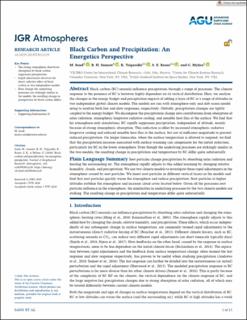| dc.contributor.author | Sand, Maria | |
| dc.contributor.author | Samset, Bjørn Hallvard | |
| dc.contributor.author | Tsigaridis, Kostas | |
| dc.contributor.author | Bauer, Susanne E. | |
| dc.contributor.author | Myhre, Gunnar | |
| dc.date.accessioned | 2021-08-25T08:16:17Z | |
| dc.date.available | 2021-08-25T08:16:17Z | |
| dc.date.created | 2020-07-23T10:48:41Z | |
| dc.date.issued | 2020 | |
| dc.identifier.citation | Journal of Geophysical Research (JGR): Space Physics. 2020, 125 (13), . | en_US |
| dc.identifier.issn | 2169-9380 | |
| dc.identifier.uri | https://hdl.handle.net/11250/2771100 | |
| dc.description.abstract | Black carbon (BC) aerosols influence precipitation through a range of processes. The climate response to the presence of BC is however highly dependent on its vertical distribution. Here, we analyze the changes in the energy budget and precipitation impacts of adding a layer of BC at a range of altitudes in two independent global climate models. The models are run with atmosphere‐only and slab ocean model setup to analyze both fast and slow responses, respectively. Globally, precipitation changes are tightly coupled to the energy budget. We decompose the precipitation change into contributions from absorption of solar radiation, atmospheric longwave radiative cooling, and sensible heat flux at the surface. We find that for atmosphere‐only simulations, BC rapidly suppresses precipitation, independent of altitude, mainly because of strong atmospheric absorption. This reduction is offset by increased atmospheric radiative longwave cooling and reduced sensible heat flux at the surface, but not of sufficient magnitude to prevent reduced precipitation. On longer timescales, when the surface temperature is allowed to respond, we find that the precipitation increase associated with surface warming can compensate for the initial reduction, particularly for BC in the lower atmosphere. Even though the underlying processes are strikingly similar in the two models, the resulting change in precipitation and temperature by BC differ quite substantially. | en_US |
| dc.language.iso | eng | en_US |
| dc.publisher | John Wiley & Sons, Inc. | en_US |
| dc.rights | Navngivelse 4.0 Internasjonal | * |
| dc.rights.uri | http://creativecommons.org/licenses/by/4.0/deed.no | * |
| dc.title | Black Carbon and Precipitation: An Energetics Perspective | en_US |
| dc.type | Journal article | en_US |
| dc.type | Peer reviewed | en_US |
| dc.description.version | publishedVersion | en_US |
| dc.source.pagenumber | 0 | en_US |
| dc.source.volume | 125 | en_US |
| dc.source.journal | Journal of Geophysical Research (JGR): Space Physics | en_US |
| dc.source.issue | 13 | en_US |
| dc.identifier.doi | 10.1029/2019JD032239 | |
| dc.identifier.cristin | 1820291 | |
| dc.relation.project | Norges forskningsråd: 244141 | en_US |
| cristin.ispublished | true | |
| cristin.fulltext | original | |
| cristin.qualitycode | 2 | |

